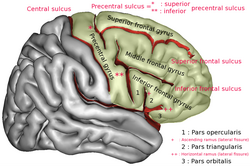Inferior frontal gyrus
| Inferior frontal gyrus | |
|---|---|
 Inferior frontal gyrus of the human brain, gyrus frontalis inferior. | |
 Lateral surface of left hemisphere viewed from the side. Inferior frontal gyrus shown in yellow. | |
| Details | |
| Part of | Frontal lobe |
| Parts | Pars opercularis, Pars triangularis, Pars orbitalis |
| Artery | Middle cerebral |
| Identifiers | |
| Latin | gyrus frontalis inferior |
| NeuroNames | 85 |
| NeuroLex ID | birnlex_873 |
| TA98 | A14.1.09.113 A15.2.07.058 |
| TA2 | 5447 |
| FMA | 61860 |
| Anatomical terms of neuroanatomy | |
The inferior frontal gyrus (IFG), (gyrus frontalis inferior), is the lowest positioned gyrus of the frontal gyri, of the frontal lobe, and is part of the prefrontal cortex.
Its superior border is the inferior frontal sulcus (which divides it from the middle frontal gyrus), its inferior border is the lateral sulcus (which divides it from the superior temporal gyrus) and its posterior border is the inferior precentral sulcus. Above it is the middle frontal gyrus, behind it is the precentral gyrus.[1]
The inferior frontal gyrus contains Broca's area, which is involved in language processing and speech production.
Structure
The inferior frontal gyrus is highly convoluted and has three cytoarchitecturally diverse regions.[2] The three subdivisions are an opercular part, a triangular part, and an orbital part. These divisions are marked by two rami arising from the lateral sulcus.[3] The ascending ramus separates the opercular and triangular parts.[4] The anterior (horizontal) ramus separates the triangular and orbital parts.[5]
- Opercular part of inferior frontal gyrus (pars opercularis), (cortex posterior to the ascending ramus of the lateral sulcus), is the part of frontal lobe that overlies the insular cortex and may be associated with recognizing a tone of voice in spoken native languages.[6] This expands on previous work[7] indicating that comprehension of inflectional morpheme processing is associated with the inferior frontal gyrus.
- Triangular part of inferior frontal gyrus (pars triangularis), (cortex between the ascending ramus and the horizontal ramus of the lateral sulcus). It may be associated with the ability to translate from a secondary or tertiary language back to one's native language.[8]
- Orbital part of inferior frontal gyrus (pars orbitalis) (cortex inferior and anterior to the horizontal ramus of the lateral sulcus)
Cytoarchitecturally the opercular part of the inferior frontal gyrus is known as Brodmann area 44 (BA44). The triangular part of the inferior frontal gyrus is known as Brodmann area 45 (BA45), and the orbital part of the inferior frontal gyrus is known as Brodmann area 47. The opercular part and the triangular part (BA44 and BA45) make up Broca's area.
Function
The inferior frontal gyrus has a number of functions including the processing of speech and language in Broca's area. Neural circuitry has been shown to connect different sites of stimulus to other regions of response including other subdivisions and also other frontal gyri.[2]
Language processing
The left opercular part of the inferior frontal gyrus is a part of the articulatory network involved in motor syllable programs. The articulatory network also contains the premotor cortex, and the anterior insula. These areas are interrelated but have specific functions in speech comprehension and production. The articulatory network acts mostly when the vocal tract moves to produce syllables. The pars opercularis acts indirectly through the motor cortex to control the motor aspect of speech production, and codes motor programs for this system, while the auditory cortex (via the temporoparietal junction in the lateral sulcus (Sylvian fissure) houses a series of sensory targets. Together, these areas function as a sensory-motor loop for syllable information coding.[citation needed]
In a study conducted comparing phonological and arithmetic processing and the involvement of different sections of the inferior frontal gyrus and angular gyrus, cortical activation for phonology, subtraction, and multiplication tasks was compared. The predetermined language-calculation network was limited to the left inferior frontal gyrus, angular gyrus, superior parietal lobule, and the horizontal portion of the intraparietal sulcus. The results were significant to support that there was a pattern of left lateralization for each of these tasks all activating the Perisylvian fissure network, with some general localized areas for phonology and arithmetic. It was supported that phonology activated the pars opercularis (BA44), and anterior angular gyrus, multiplication mainly implicated the pars triangularis (BA45), and the posterior angular gyrus. These systems are activated through similar neuronal processes but independently placed along the network.[citation needed]
Language comprehension and production
Most language processing takes place in
The right opercular part of the IFG, (BA44) has been implicated in
Additional images
-
Inferior frontal gyrus highlighted in green on coronal T1 MRI images
-
Inferior frontal gyrus highlighted in green on sagittal T1 MRI images
-
Inferior frontal gyrus highlighted in green on transversal T1 MRI images
References
- ISBN 978-0-323-01320-8photos on p526 & p.546
- ^ S2CID 5685566.
- ^ "anterior ramus of lateral cerebral sulcus". TheFreeDictionary.com.
- ^ Gaillard, Frank. "Ascending ramus of the lateral sulcus | Radiology Reference Article | Radiopaedia.org". Radiopaedia.
- ^ Gaillard, Frank. "Anterior ramus of the lateral sulcus | Radiology Reference Article | Radiopaedia.org". Radiopaedia.
- PMID 29223785.
- S2CID 16112201.
- PMID 27746729.
- ISBN 978-0-07-021530-6). p.1055
{{citation}}:|first=has generic name (help)CS1 maint: multiple names: authors list (link - ^ Sharot, T., Kanai, R., Marston, D., Korn, C. W., Rees, G. & Dolan, R.J. (2012) Selectively Altering Belief Formation in the Human Brain. Proceedings of the National Academy of Sciences, 109 (42), 17058–17062.
- S2CID 19332756.
- PMID 19812332.
- PMID 16775134.
- PMID 17553993.



